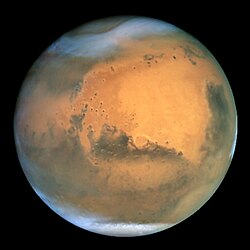Mars Climate Orbiter
 Mars Climate Orbiter under ett akustiskt test | |
| Status | Misslyckad |
|---|---|
| Typ | Kretsare |
| Organisation | NASA |
| Större entreprenör | Lockheed Martin |
| NSSDC-ID | 1998-073A[1] |
| Uppskjutning | |
| Uppskjutningsplats | Cape Canaveral Air Force Station, SLC-17A |
| Uppskjutning | 11 december 1998, 18:45:51 UTC |
| Uppskjutningsfarkost | Delta II |
| Egenskaper | |
| Massa | 338 kg |
| Effekt | 500 watt |
Mars Climate Orbiter (tidigare känd som Mars Surveyor '98 Orbiter) var en av två farkoster i Mars Surveyor '98-programmet, den andra är Mars Polar Lander. Uppdraget var att studera det marsianska vädret, klimatet och vatten- och koldioxidinnehåll, för att kunna få bättre förståelse för långsiktiga klimatändrigar på Mars.
Mars Climate Orbiter förstördes när ett navigationsfel orsakade att farkosten fick felaktig höjd då den gick in i omloppsbana. Farkosten förstördes av friktionen och påfrestningarna i Mars atmosfär. En undersökning visade att några data för raketsystemet beräknades i engelska enheter (pound-force-sekund) medan navigationsteamet förväntade sig SI-enheter (newton-sekund). [2]
Källor
Fotnoter
- ^ ”NASA Space Science Data Coordinated Archive” (på engelska). NASA. https://nssdc.gsfc.nasa.gov/nmc/spacecraft/display.action?id=1998-073A. Läst 29 mars 2020.
- ^ Referat av haverirapporten.
| ||||||||||||||||||||||||||||||||||||||||||||||||||||||||
Media som används på denna webbplats
NASA's Hubble Space Telescope took the picture of Mars on June 26, 2001, when Mars was approximately 68 million kilometers (43 million miles) from Earth — the closest Mars has ever been to Earth since 1988. Hubble can see details as small as 16 kilometers (10 miles) across. The colors have been carefully balanced to give a realistic view of Mars' hues as they might appear through a telescope. Especially striking is the large amount of seasonal dust storm activity seen in this image. One large storm system is churning high above the northern polar cap (top of image), and a smaller dust storm cloud can be seen nearby. Another large dust storm is spilling out of the giant Hellas impact basin in the Southern Hemisphere (lower right).
The Mars Surveyor '98 Climate Orbiter is shown here during acoustic tests that simulate launch conditions. The orbiter was to conduct a two year primary mission to profile the Martian atmosphere and map the surface. To carry out these scientific objectives, the spacecraft carried a rebuilt version of the pressure modulated infrared radiometer, lost with the Mars Observer spacecraft, and a miniaturized dual camera system the size of a pair of binoculars, provided by Malin Space Science Systems, Inc., San Diego, California. During its primary mission, the orbiter was to monitor Mars atmosphere and surface globally on a daily basis for one Martian year (two Earth years), observing the appearance and movement of atmospheric dust and water vapor, as well as characterizing seasonal changes of the planet's surface. Imaging of the surface morphology would also provide important clues about the planet's climate in its early history. The mission was part of NASA's Mars Surveyor program, a sustained program of robotic exploration of the red planet, managed by the Jet Propulsion Laboratory for NASA's Office of Space Science, Washington, DC. Lockheed Martin Astronautics was NASA's industrial partner in the mission. Unfortunately, Mars Climate Orbiter burned up in the Martian atmosphere on September 23, 1999, due to a metric conversion error that caused the spacecraft to be off course.


